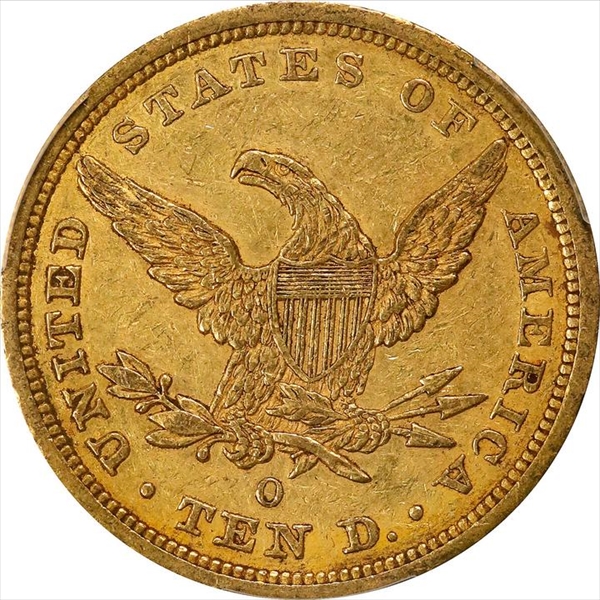1843-O $10 N1 认证号45410023, PCGS号8589
专家评论
Doug Winter
The mintage for this issue is considerably larger than for the 1842-O and it is the second most available New Orleans eagle from the 1840s, trailing only the 1847-O. Unlike the 1847-O, it is very rare in higher grades and it compares favorably to such issues as the 1845-O and the 1848-O in AU55 and above.The 1843-O is the second most available New Orleans eagle from the 1840s. It is comparatively available in lower grades with most examples found in the VF and EF range. It is very scarce in properly graded AU50 to 53 and it becomes very rare in the higher AU grades. In Uncirculated, this is an extremely rare issue and there are none currently known that grade higher than MS62.
STRIKE: Around 75% of all known 1843-O eagles are lightly struck at the obverse center, especially on the curls around the face and behind the ear. The reverse is better struck, although the lettering may appear to be somewhat light at the tops and there is often weakness on the eagle’s right leg and neck feathers. Around 25% of all known 1842-O eagles show a much sharper strike at the central obverse (these may be the earliest die state), and these should sell for a premium over coins that are weak at the centers.
SURFACES: This issue is found with better surfaces than some of the other New Orleans eagles from the early 1840s. It is certainly not easy to find with clean surfaces; it just tends to be seen with fewer deep, detracting abrasions than such dates as the 1842-O, 1844-O and 1846-O. Some I have seen have mint-made planchet chips and others have small copper spots or areas of discoloration. A few have matte-like surfaces from exposure to seawater.
LUSTER: The luster is usually frosty but more subdued in its texture than on the 1842-O. A few have prooflike surfaces but these are often very heavily abraded and not attractive as a result. It is very hard to find an 1843-O eagle with good luster and even those that have not been cleaned or dipped tend to be subdued in appearance.
COLORATION: The natural coloration is a medium to deep green-gold. There are more original examples of this date than other issues from the early 1840s but a number of the uncleaned, original coins have a somewhat dirty, “splotchy” appearance with dark coloration on the high spots that may be unattractive to many viewers. Many higher grade pieces have been cleaned or dipped at one time.
EYE APPEAL: The typical 1843-O eagle has average to below average eye appeal. Many are weakly struck at the centers and may have a somewhat sunken look at the middle of the obverse. The surfaces are often abraded and the luster is not vibrant. Many of the original, uncleaned pieces do not exhibit especially attractive color.
DIE CHARACTERISTICS: On some, the obverse shows die rust. This is most clearly seen on the neck and face of Liberty. On the reverse there are numerous raised die lines in the shield and what appears to be a clashmark at the inside of the eagle’s neck. On high grade coins, there are some raised, faint die lines that run from the lower part of the eagle’s left wing to the claws.
MAJOR VARIETIES: There appear to be just two varieties and it is possible that one represents a lapped die or a later die state of the other:
Variety One: The date is thin, especially at the top loop of the 8. The mintmark is somewhat high and placed to the left of the arrow feather with the feather pointing towards the 2:00 position of the O. It is placed over the EN in TEN. There are a number of cracks seen on the reverse and on some, these are fairly prominent. The Bass III: 584 coin is a good example of a very late reverse die state. Breen-6862.
Variety Two: The date is much sharper than on the last. Same reverse as on Variety One but without the advanced cracks. Breen-6863.
David Akers (1975/88)
Although moderately scarce in all grades, the 1843-O is not as rare in high grade as any of the Liberty Head issues discussed so far. A small number of AU pieces exist as well as several rather average quality uncirculated specimens. I have not seen or heard of a truly choice mint state example, however. As is the case with most Liberty Head Eagles, VF or EF is the condition most likely to be available. Many, if not most, specimens have prooflike or partially prooflike surfaces.PCGS #
8589
设计师
Christian Gobrecht
边缘
Reeded
直径
26.80 毫米
重量
16.70 克
铸币数量
175162
金属成分
90% Gold, 10% Copper
更高评级数量
370
评级较低的钱币数量
0
地区
The United States of America
价格指南
PCGS 数量报告
拍卖 - PCGS 评级的
拍卖 - NGC 评级的
稀有性和存量估计 了解更多
| 所有评级 | 325 |
| 60或以上 | 6 |
| 65或以上 | 0 |
| 所有评级 | R-6.3 |
| 60或以上 | R-9.7 |
| 65或以上 | R-10.1 |
| 所有评级 | 53 / 64 TIE |
| 60或以上 | 26 / 64 TIE |
| 65或以上 | 1 / 64 |
| 所有评级 | 97 / 183 TIE |
| 60或以上 | 44 / 183 TIE |
| 65或以上 | 1 / 183 |






















